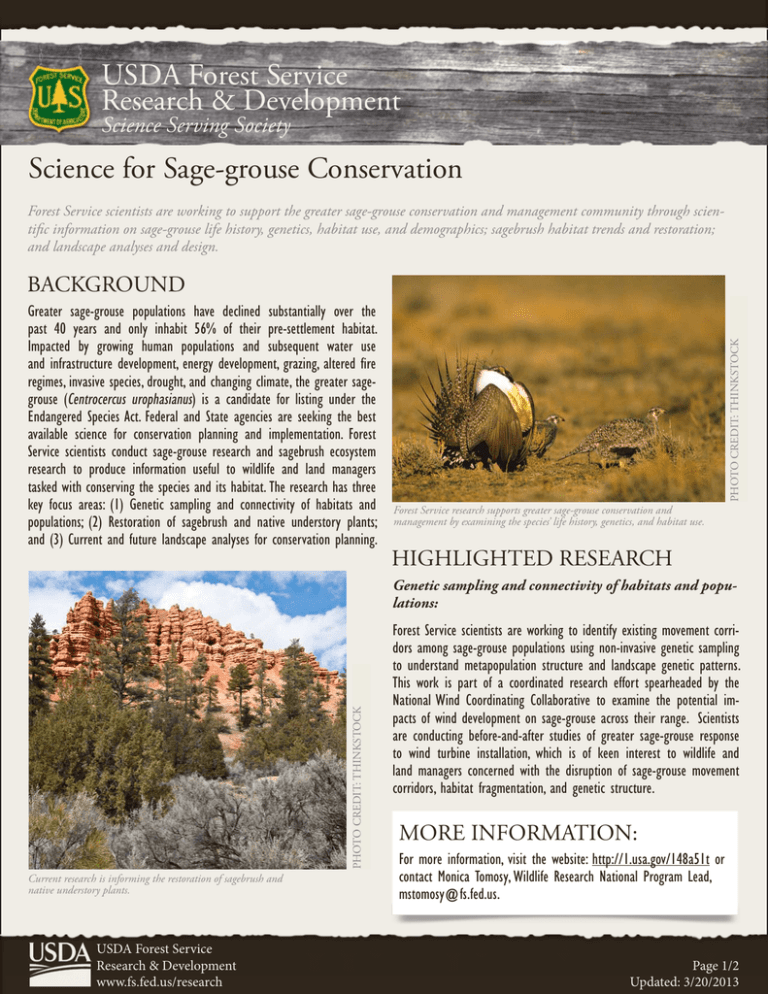USDA Forest Service Research & Development Science for Sage-grouse Conservation Science Serving Society
advertisement

USDA Forest Service Research & Development Science Serving Society Science for Sage-grouse Conservation Forest Service scientists are working to support the greater sage-grouse conservation and management community through scientific information on sage-grouse life history, genetics, habitat use, and demographics; sagebrush habitat trends and restoration; and landscape analyses and design. Greater sage-grouse populations have declined substantially over the past 40 years and only inhabit 56% of their pre-settlement habitat. Impacted by growing human populations and subsequent water use and infrastructure development, energy development, grazing, altered fire regimes, invasive species, drought, and changing climate, the greater sagegrouse (Centrocercus urophasianus) is a candidate for listing under the Endangered Species Act. Federal and State agencies are seeking the best available science for conservation planning and implementation. Forest Service scientists conduct sage-grouse research and sagebrush ecosystem research to produce information useful to wildlife and land managers tasked with conserving the species and its habitat. The research has three key focus areas: (1) Genetic sampling and connectivity of habitats and populations; (2) Restoration of sagebrush and native understory plants; and (3) Current and future landscape analyses for conservation planning. PHOTO CREDIT: THINKSTOCK BACKGROUND Forest Service research supports greater sage-grouse conservation and management by examining the species’ life history, genetics, and habitat use. HIGHLIGHTED RESEARCH PHOTO CREDIT: THINKSTOCK Genetic sampling and connectivity of habitats and populations: Current research is informing the restoration of sagebrush and native understory plants. USDA Forest Service Research & Development www.fs.fed.us/research Forest Service scientists are working to identify existing movement corridors among sage-grouse populations using non-invasive genetic sampling to understand metapopulation structure and landscape genetic patterns. This work is part of a coordinated research effort spearheaded by the National Wind Coordinating Collaborative to examine the potential impacts of wind development on sage-grouse across their range. Scientists are conducting before-and-after studies of greater sage-grouse response to wind turbine installation, which is of keen interest to wildlife and land managers concerned with the disruption of sage-grouse movement corridors, habitat fragmentation, and genetic structure. MORE INFORMATION: For more information, visit the website: http://1.usa.gov/148a51t or contact Monica Tomosy, Wildlife Research National Program Lead, mstomosy@fs.fed.us. Page 1/2 Updated: 3/20/2013 HIGHLIGHTED RESEARCH CONTINUED: Restoration of sagebrush and the native understory: Forest Service researchers are participating in a regional experiment, The Sagebrush Steppe Treatment Evaluation Project (SageSTEP), to evaluate methods for restoring sagebrush ecosystems exhibiting cheatgrass invasion and pinyon and juniper expansion in the Great Basin. Partners and collaborators include the Joint Fire Sciences Program, other federal agencies, western universities, public and private natural resource managers, tribal governments, and nongovernmental organizations. Current and future landscape analyses for conservation planning: PHOTO CREDIT: THINKSTOCK Forest Service scientists evaluated the effects of future scenarios of vegetation change on populations of greater sage-grouse. They modeled sagebrush-steppe habitat with and without active and passive restoration. Under projections with no active management, widespread extirpation of sage-grouse was predicted; however, active restoration scenarios led to persistence of sage-grouse populations in much of their current range. Given the amount of sage-grouse habitat remaining, specific outcomes of Agency policies and regulations encourage the use of native species to available future habitat were projected for various restoration scenarios. restore ecosystem structure, function and services on public lands. To transition from seeding monocultures to planting mixtures of shrubs, Using novel landscape modeling methods across the entire range of the grasses, and forbs, Forest Service scientists are evaluating site preparation species, Forest Service scientists evaluated 22 environmental factors asto control invasive species while retaining soil microbiota; biological soil sociated with extirpation or persistence of sage-grouse populations. The crusts and residual native plants; plant-plant interactions; seeding and models revealed five prime indicators for the presence or absence of the establishment requirements; and availability of equipment to meet these species: the amount of sage-brush, elevation, proximity to transmission needs. These research results can support federal, State, and private lines and to cellular towers, and landownership. This work is part of a monograph that served at the foundation for the 2010 evaluation of natural resource management efforts to restore sage grouse habitat. greater sage-grouse for listing under the Endangered Species Act by the US Fish & Wildlife Service. Sagebrush habitat is impacted by growing human populations and subsequent water use and infrastructure development, energy development, grazing, altered fire regimes, invasive species, drought, and changing climate. Forest Service scientists used models to map the probabilities of environmental similarity of areas currently occupied by sage-grouse with areas where extirpation has occurred. Areas in red show high similarity with extirpated range. Areas in beige show low similarity. USDA Forest Service Research & Development www.fs.fed.us/research Note: In spring 2013, the Forest Service will send a questionnaire to National Forest and Grassland managers to identify their top priority research needs and knowledge gaps to inform management for sage-grouse and sagebrush. If you would like to share your sage-grouse conservation needs with us, please write to Mary Rowland (mrowland@fs.fed.us) and we will include your interests in this needs assessment, for our strategic planning process. Page 2/2 Updated: 3/20/2013











